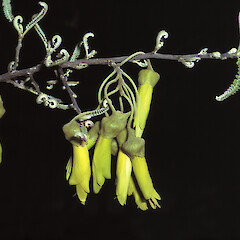Sophora fulvida
Common name
kōwhai
Synonyms
Sophora microphylla var. fulvida Allan; Sophora microphylla subp. microphylla var. fulvida (Allan) Yakovlev
Family
Fabaceae
Flora category
Vascular – Native
Endemic taxon
Yes
Endemic genus
No
Endemic family
No
Structural class
Trees & Shrubs - Dicotyledons
NVS code
The National Vegetation Survey (NVS) Databank is a physical archive and electronic databank containing records of over 94,000 vegetation survey plots - including data from over 19,000 permanent plots. NVS maintains a standard set of species code abbreviations that correspond to standard scientific plant names from the Ngä Tipu o Aotearoa - New Zealand Plants database.
SOPFUL
Chromosome number
2n = 18
Current conservation status
The conservation status of all known New Zealand vascular plant taxa at the rank of species and below were reassessed in 2017 using the New Zealand Threat Classification System (NZTCS) – more information about this can be found on the NZTCS website. This report includes a statistical summary and brief notes on changes since 2012 and replaces all previous NZTCS lists for vascular plants.
Please note, threat classifications are often suggested by authors when publications fall between NZTCS assessment periods – an interim threat classification status has not been assessed by the NZTCS panel.
- Conservation status of New Zealand indigenous vascular plants, 2017 . 2018. Peter J. de Lange, Jeremy R. Rolfe, John W. Barkla, Shannel P. Courtney, Paul D. Champion, Leon R. Perrie, Sarah M. Beadel, Kerry A. Ford, Ilse Breitwieser, Ines Schönberger, Rowan Hindmarsh-Walls, Peter B. Heenan and Kate Ladley. Department of Conservation. Source: NZTCS and licensed by DOC for reuse under the Creative Commons Attribution 4.0 International licence.
2017 | At Risk – Naturally Uncommon | Qualifiers: RR
Previous conservation statuses
2012 | At Risk – Naturally Uncommon | Qualifiers: RR
2009 | At Risk – Naturally Uncommon
2004 | Gradual Decline
Brief description
A kowhai tree bearing leaves to 140mm long that have equal-sized small yellowish-hairy leaflets 1.8-7.5 long and with bunches of drooping yellow flowers and dry ridged and knobbly seed pods 60-190mm long containing hard yellow seeds. Juvenile and adults similar. Occurring north of Raglan.
Distribution
Endemic to New Zealand, occurring in Northland, Auckland and the Waikato. The southern limit occurs at Mt Karioi on the south side of Raglan Harbour.
Habitat
Open or disturbed sites, on base-rich volcanic rock, rubble and outcrops, amongst mixed podocarp-hardwood forest.
Detailed description
A small kowhai tree to 10 m tall. It has many hairy, small, crowded, yellow-green or grey leaflets. Young branches are also hairy, and juvenile plants do not divaricate. Leaves on adults are up to 140 mm long and bear 60-90, roughly elliptical leaflets, each 1.8 to 7.5 by 1.2 to 4.5 mm. The larger juvenile leaves are almost devoid of hairs, also elliptical in shape and range in size from 2 to 3 by 4 to 6 mm. Flowers are yellow.
Similar taxa
Sophora microphylla, S. chathamica, S. godleyi and S. tetraptera could be confused with S. fulvida. These all tend to have fewer leaflets on each leaf, and leaflets which are often larger, broader, crowded and sometimes overlapping or widely spaced.
Flowering
Flowering occurs from October to November.
Flower colours
Yellow
Fruiting
Fruiting in April–May.
Propagation technique
Easy from seed. The hard seed coast should be lightly nicked or sanded to expose the endosperm. Soaking seed in water overnight before sowing often improves the germination success rate. Can be grown from cuttings but these are usually very slow and hard to strike.
Threats
Competition from weeds, especially on rocky outcrops; animal browse and loss of habitat.
Etymology
sophora: After the Arabic name for a similar tree
fulvida: Yellow
Where To Buy
Commonly sold by commercial nurseries - usually as S. microphylla var. fulvida.
Poisonous plant
All parts of the plant but especially the ripe yellow seed are poisonous. Because the seed are hard they will take a lot of chewing to cause harm. If the seed are crushed before eating it is more likely that they will cause harm. The major toxin is Cytisine and symptoms of poisoning include nausea, vomiting, increased heart rate, twitching of muscles or loss of coordination. Onset of these symptoms may occur within one hour. In extreme cases symptoms include paralysis and respiratory failure. Click on this link for more information about Poisonous native plants.
Attribution
Fact Sheet prepared for NZPCN by P.J. de Lange 1 August 2003. Description based on Heenan et al. (2001).
References and further reading
Heenan, P.B.; de Lange, P. J.; Wilton, A. D. 2001: Sophora (Fabaceae) in New Zealand: taxonomy, distribution, and biogeography. New Zealand Journal of Botany 39(1): 17-53.
NZPCN Fact Sheet citation
Please cite as: de Lange, P.J. (Year at time of access): Sophora fulvida Fact Sheet (content continuously updated). New Zealand Plant Conservation Network. https://www.nzpcn.org.nz/flora/species/sophora-fulvida/ (Date website was queried)







